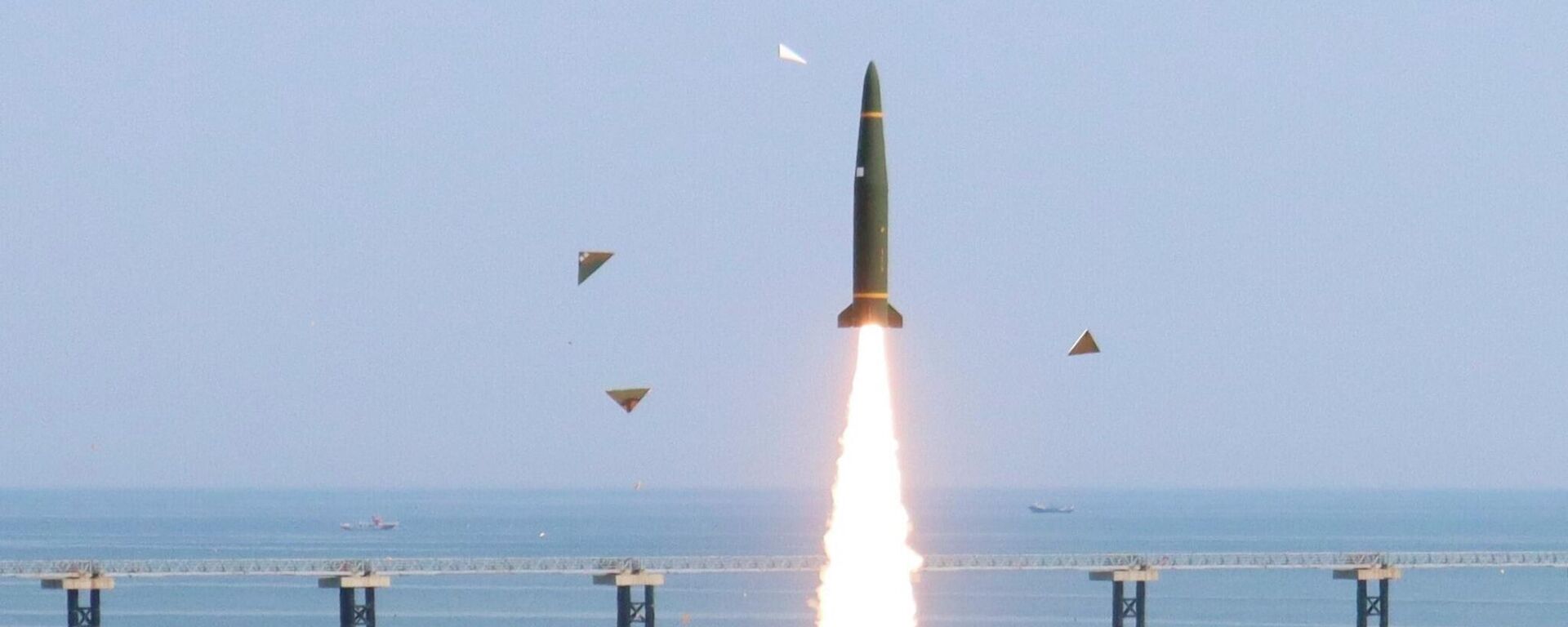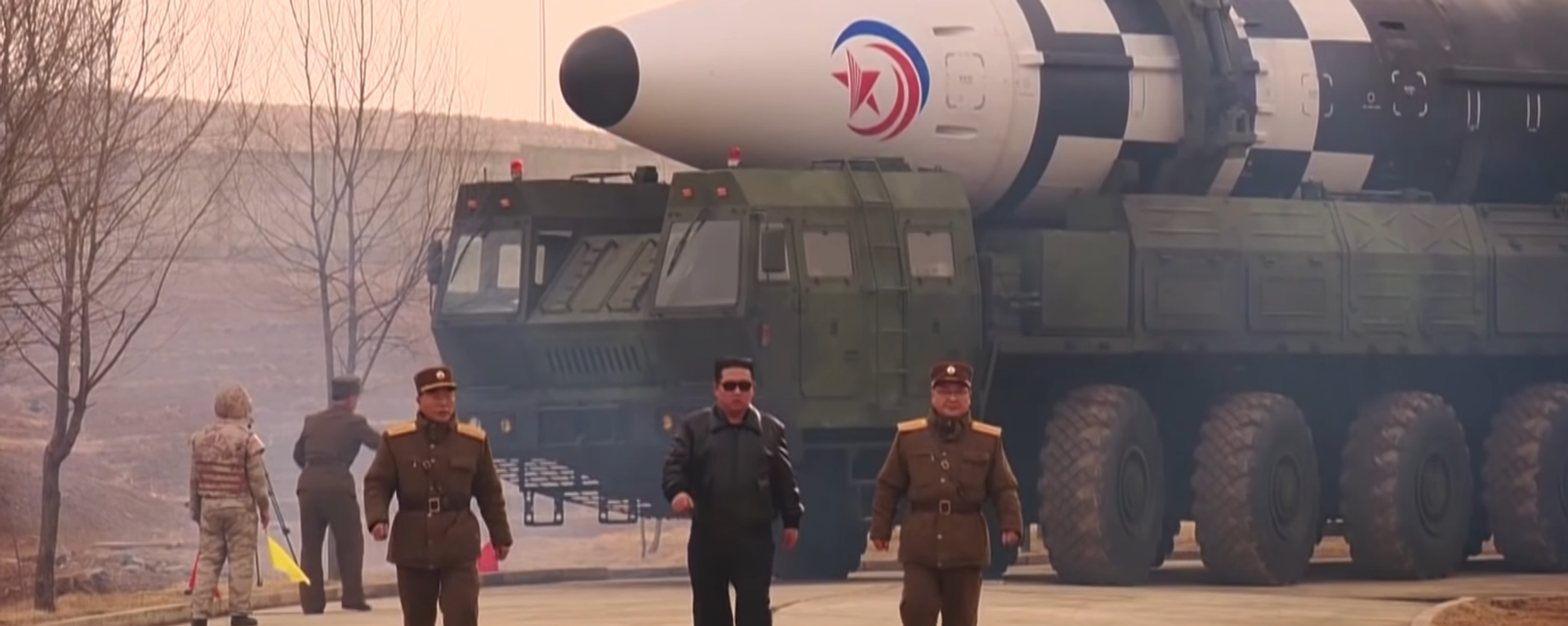https://sputnikglobe.com/20221008/dprk-defends-righteous-missile-tests-as-response-to-us-threats-1101636526.html
DPRK Defends ‘Righteous’ Missile Tests as Response to US Threats
DPRK Defends ‘Righteous’ Missile Tests as Response to US Threats
Sputnik International
Tensions on the Korean peninsula have increased dramatically over the past two weeks amid a series of North Korean missile tests conducted in response to... 08.10.2022, Sputnik International
2022-10-08T11:37+0000
2022-10-08T11:37+0000
2023-09-18T13:36+0000
missile
drills
exercises
military
north korea
https://cdn1.img.sputnikglobe.com/img/07e5/01/0f/1081771801_0:65:1193:736_1920x0_80_0_0_44286eea233597017abff6c8eee7ee56.png
The Democratic People’s Republic of Korea’s (DPRK’s) latest missile test constituted a “regular and planned self-defensive step for defending the country’ security and regional peace from the US’s direct military threats that have lasted for more than half a century,” a spokesperson from North Korea’s National Aviation Administration announced Saturday.In a separate statement Saturday, a North Korean Ministry of National Defense spokesman warned that the US deployment of the Ronald Reagan carrier strike group in the Sea of Japan and drills together with South Korean “puppet forces” threatens to provoke a “huge negative splash to the regional situation.”North Korea conducted half-a-dozen ballistic missile tests over the past two weeks in the face of growing US, South Korean and Japanese drills in the area, with the latest launch carried out Thursday and consisting of the firing of a pair of short-range missiles toward the DPRK’s east coast. On Tuesday, Pyongyang fired an intermediate-range ballistic missile over the northern Japanese island of Hokkaido, with the missile splashing down in the Pacific Ocean, about 3,000 km east of Japan.The missile involved, believed to be the Hwasong-12, has a range of up to 6,000 km, enough to strike the US Pacific territory of Guam in the event of a conflict. The launch was the first of its kind in five years.South Korea and the US kicked off a new two-day naval exercise on Friday, less than 24 hours after wrapping up trilateral drills with Japan in the Sea of Japan. A Pentagon spokesperson warned Thursday that the US expects Pyongyang to conduct a new nuclear test, and promised to “consult closely” with regional allies and partners to “respond appropriately to any potential future provocative acts by North Korea.”Amid the heightened tensions, Chinese Deputy Permanent Representative to the United Nations Geng Shuang called on the Security Council to “play a constructive role on the Korean Peninsula issue instead of relying solely on strong rhetoric or pressure.”North Korea unveiled an updated military doctrine last month officially declaring the country to be a nuclear weapons state. The doctrine allows for nuclear weapons to be used in the event of an enemy nuclear attack, a large-scale conventional attack, or attempted decapitation strike. The document characterizes the country’s strategic deterrent as a “powerful means for defending the sovereignty, territorial integrity and fundamental interests of the state” and a means for preventing war on the Korean Peninsula.Relations between Pyongyang and Washington have worsened dramatically over the past year-and-a-half, in part thanks to the breakdown of the face-to-face diplomacy carried out by Kim Jong-un and Donald Trump during the latter’s tenure in office. Joe Biden repeatedly attacked Trump for negotiating with the “thug” and “tyrant” North Korean leader on the campaign trail in 2020, prompting Pyongyang to dub Biden an “imbecile” and “rabid dog” who should “be beaten to death with a stick.”The Bulletin of the Atomic Scientists estimates that North Korea has enough fissile material to build between 45 and 55 nuclear weapons, and the country’s Hwasong-15 and Hwasong-17 intercontinental ballistic missiles give Pyongyang the theoretical capability to hit any point in the continental United States, endowing the country with the ability to deter foreign aggression.
https://sputnikglobe.com/20221007/south-korea-and-us-launch-another-joint-military-exercise-in-sea-of-japan-1101595131.html
https://sputnikglobe.com/20221004/north-korean-missile-flew-4600-km-with-maximum-altitude-of-1000-km---japanese-cabinet-1101484170.html
https://sputnikglobe.com/20220909/dprks-new-nuclear-doctrine-is-cheapest-fastest-way-to-get-deterrent-us-will-take-seriously-prof-1100602477.html
north korea
Sputnik International
feedback@sputniknews.com
+74956456601
MIA „Rossiya Segodnya“
2022
News
en_EN
Sputnik International
feedback@sputniknews.com
+74956456601
MIA „Rossiya Segodnya“
Sputnik International
feedback@sputniknews.com
+74956456601
MIA „Rossiya Segodnya“
missile, drills, exercises, north korea
missile, drills, exercises, north korea
DPRK Defends ‘Righteous’ Missile Tests as Response to US Threats
11:37 GMT 08.10.2022 (Updated: 13:36 GMT 18.09.2023) Tensions on the Korean peninsula have increased dramatically over the past two weeks amid a series of North Korean missile tests conducted in response to large-scale air, sea, land and missile drills being carried out by the United States and its regional allies. Each side has accused the other of stoking tensions.
The Democratic People’s Republic of Korea’s (DPRK’s) latest missile test constituted a “regular and planned self-defensive step for defending the country’ security and regional peace from the US’s direct military threats that have lasted for more than half a century,” a spokesperson from North Korea’s National Aviation Administration
announced Saturday.
The tests do not “pose any threat [or] harm to the safety of not only civil aviation but also the neighboring countries and region,” the spokesperson added, dismissing a recent statement by the International Civil Aviation Organization condemning the missile launches. The spokesperson dismissed the ICAO’s criticism as “a political provocation of the US and its vassal forces aimed to infringe upon” Pyongyang’s sovereignty.
In a separate statement Saturday, a North Korean Ministry of National Defense spokesman
warned that the US deployment of the Ronald Reagan carrier strike group in the Sea of Japan and drills together with South Korean “puppet forces” threatens to provoke a “huge negative splash to the regional situation.”
The spokesman characterized the deployment as “a sort of military bluffing meant to issue a so-called warning to the righteous reaction shown by the Korean People’s Army to the extremely provocative and threatening joint military drills of the US and South Korea.”

7 October 2022, 07:44 GMT
North Korea conducted half-a-dozen ballistic missile tests over the past two weeks in the face of growing US, South Korean and Japanese drills in the area, with the latest launch carried out Thursday and consisting of the
firing of a pair of short-range missiles toward the DPRK’s east coast. On Tuesday, Pyongyang fired an intermediate-range ballistic missile over the northern Japanese island of Hokkaido, with the missile splashing down in the Pacific Ocean, about 3,000 km east of Japan.
The missile involved, believed to be the Hwasong-12, has a range of up to 6,000 km, enough to strike the US Pacific territory of Guam in the event of a conflict. The launch was the first of its kind in five years.

4 October 2022, 02:08 GMT
South Korea and the US kicked off a new two-day naval exercise on Friday, less than 24 hours after wrapping up trilateral drills with Japan in the Sea of Japan. A Pentagon spokesperson warned Thursday that the US expects Pyongyang to conduct a new nuclear test, and
promised to “consult closely” with regional allies and partners to “respond appropriately to any potential future provocative acts by North Korea.”
Amid the heightened tensions, Chinese Deputy Permanent Representative to the United Nations Geng Shuang
called on the Security Council to “play a constructive role on the Korean Peninsula issue instead of relying solely on strong rhetoric or pressure.”
North Korea unveiled an updated military doctrine last month officially declaring the country to be a nuclear weapons state. The doctrine allows for nuclear weapons to be used in the event of an enemy nuclear attack, a large-scale conventional attack, or attempted decapitation strike. The document characterizes the country’s strategic deterrent as a “powerful means for defending the sovereignty, territorial integrity and fundamental interests of the state” and a means for preventing war on the Korean Peninsula.

9 September 2022, 12:33 GMT
Relations between Pyongyang and Washington have worsened dramatically over the past year-and-a-half, in part thanks to the breakdown of the face-to-face diplomacy carried out by Kim Jong-un and Donald Trump during the latter’s tenure in office. Joe Biden repeatedly attacked Trump for negotiating with the “thug” and “tyrant” North Korean leader on the campaign trail in 2020, prompting Pyongyang to dub Biden an “imbecile” and “rabid dog” who should “be beaten to death with a stick.”
The Bulletin of the Atomic Scientists
estimates that North Korea has enough fissile material to build between 45 and 55 nuclear weapons, and the country’s Hwasong-15 and Hwasong-17 intercontinental ballistic missiles give Pyongyang the theoretical capability to hit any point in the continental United States, endowing the country with the ability to deter foreign aggression.





